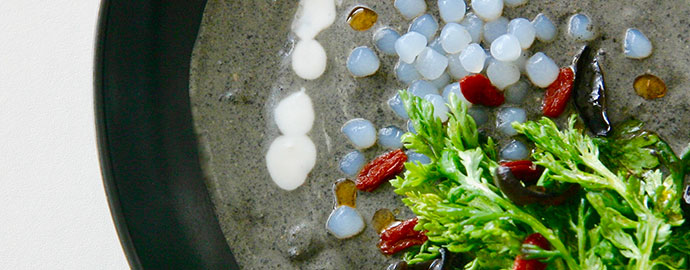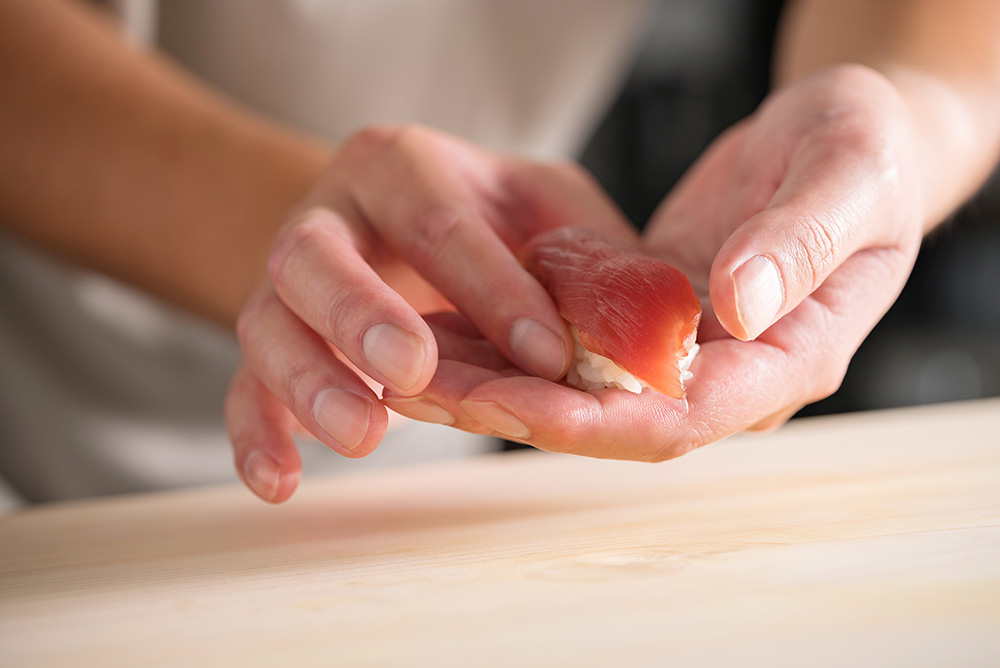
"Natural Food: Audition to Discover New Recipes"
REFLECTIONS FROM MODERATORS
MAIN DISHES DIVISION
EMIKA IWATA, Vegan Food Analyst
Q: What was your take on “Natural Food: Audition to Discover New Recipes”?
There are countless recipe contests, but I felt that this contest was aligned with our times, in its perspective on health and related issues of food safety and trust, and its background in areas such as care for the environment. Some of the contestants addressed veganism, which links to dealing with growing inbound demand, as well as allergies. I thought that this was an event that met all kinds of demand around the world. I also think there’s no other contest so strong in the thought and feeling the finalists put into their cookery. They all had ideas they wanted to convey, such as food diversity and the importance of health through food, and I could tell that they were addressing those ideas in this event.
Q: What impression did you get from the contents and taste testing of the recipes offered by the four finalists (in the Main Dishes Division) at this event?
 I think all the finalists expressed their own world views.
I think all the finalists expressed their own world views.
For Omata, it's "the beauty and art of cooking". Her offering was like a single work of art that also includes flavor. She addresses anti-aging and women's hormone balance with food, and also wants to provide emotional stimulation with the visual beauty of food.
For Takahashi, it's "universal food". Her calamari-style recipe is an idea that can be arranged to suit vegans, as well as "oriental vegetarians" (who exclude the five pungent roots of Buddhism and are numerous in Taiwan) and gluten-free people, so it is "barrier-free" for all kinds of food. It was also barrier-free in the sense that it can taste good to anyone, regardless of flavor preferences, likes and dislikes.
For Takanashi, it's thoughtfulness. It's no simple thing to take diverse ingredients, some of them with slightly odd flavors, and finish them into something delicious. I could feel that she looks at each individual ingredient with love, thoroughly understands their characteristics, and combines them in ways that make them suit each other well. I saw her kindness in the way that she cooks with constant thoughtfulness for the ingredients and for the people who eat them.
For Quiles, it's "pursue the essence". She took tiger nuts as an ingredient and comprehensively communicated their appeal. Tiger nuts are grown without using chemicals, and the pulp that is left after squeezing them for nut milk is used in various kinds of cookery. The background to the widespread adoption of natural food goes beyond the perspective of healthful ingredients, as people have come to think more broadly about the social issues of the environment and food losses.
In Quiles' recipe I could see the good characteristics of natural foods, as kinder to people and the Earth, as well as tasting their delicious flavors.
Q: What would you like to see the finalists do in future?
I expect demand for natural food to grow much further in future. There are many ingredientst hat people are generally unfamiliar with, and those who say there are high hurdles in the way of using natural foods in bar and restaurant menus have a point. Simple and tasty. I'd like them to try harder to create menu items that are simplified to be easier to offer in bars and restaurants.
Q: Next year will be the third time for this event. What are your expectations for it?
The ways people experience meals are shifting towards "kindness to people and the Earth". If there were more healthy people, this world would be more emotionally tranquil and free of conflict. If there's food that everyone can eat, like vegan food, everyone can sit around the same table and start talking, and there will be more smiling faces. If the food is also made from environment-friendly ingredients, the Earth we live on would also be happier. The dishes that were offered at this event are the kind that make everyone happy.
The finalists are rivals, competing on stage for the Grand Prix. But they were also comrades, with the common theme of world peace through food in their hearts. "Natural Food: Audition to Discover New Recipes" is a place where high-minded people with such ideas can participate, and in future I want it to continue to be also a forum for disseminating those ideas to the masses.
SWEETS DIVISION
MAYUMI MUROYA, Representative Director, Beauty Food Association
Q: This was the second "Natural Food: Audition to Discover New Recipes" event. What is your frank appraisal of it?
I've been watching since the first event, and I think it's a very well-timed project, blazing a trail in Japan's modern era. I see it as a wonderful opportunity for all kinds of people to take on the challenge of discovering new natural recipes, and to raise their interest and concern about natural foods.
Q: What impression did you get from the contents and taste testing of the recipes offered by the four finalists (in the Sweets Division) at this event? How did you go about assessing and scoring them?
The finalists all offered wonderful recipes, and I felt that these were visually vivid and ideal as natural confectionery items. It was difficult to rank them, but in my personal assessment, they all had delicious flavors in common, so I scored them for their appearance and reproducibility.
Q: Which of the recipes made the most lasting impression on you? Why was that?
Raw cheese cake has a good reputation with everyone, it tastes good, and is easy to make. The Unicorn Raw Cheese Cake that took the Grand Prix this time had just the right coloring for spring, which was very exciting and made an excellent impression. It's fun in a way that will trick, in a good sense, men and women, young and old, and people who are trying animal-free confectionery for the first time, and that’s a great thing.
Q: Is there anything you would like the finalists to move towards in future, or expectations for them?
Getting to be a finalist from among so many entrants is a fine thing, and I'm very grateful to them for taking the challenge. I want even those who did not win to draw great self confidence from being among the finalists, and from the value of that experience. I very much hope that they will use that in future to take on further challenges and do great things.
Q: Next year will be the third time for this event. What are your expectations for it? How do you think it should be?
 Within the range of natural foods, some combine different categories, such as vegan and gluten-free, and some do not. I think that the general judges should have the knowledge necessary to take aspects such as being vegan, or raw, or gluten-free, as points for assessment. I think it is also important to see these recipes as a separate genre, rather than comparing them against ordinary confectionery that uses ingredients like dairy products, eggs, and white sugar. Also, to develop the genre of vegan confectionery, I very much want the entrants to study and to strive with veganism in mind in future.
Within the range of natural foods, some combine different categories, such as vegan and gluten-free, and some do not. I think that the general judges should have the knowledge necessary to take aspects such as being vegan, or raw, or gluten-free, as points for assessment. I think it is also important to see these recipes as a separate genre, rather than comparing them against ordinary confectionery that uses ingredients like dairy products, eggs, and white sugar. Also, to develop the genre of vegan confectionery, I very much want the entrants to study and to strive with veganism in mind in future.
REFLECTIONS
FROM FINALIST & EXHIBITOR
Q: How did you like competing with everyone on a specially-built stage?
I was very happy to be one of the fi nalists. It was an honor to add mine the exquisite recipes of highly-experienced pros from this fi eld. I was worried because my recipes are too simple and plain, so I have no highlights to show off.
Q: What is "Tiger Nut Pulp Salad"?
The crumbly residue that's left after tiger nuts are squeezed to make horchata is called "pulp". The pulp left after squeezing is excellent stuff, with a subtle sweetness left in it. You can sprinkle it on salads, blend it into sauces, and mix it with other ingredients. You can add it to burger patties, gyoza dumplings, cookies and crackers, and bread, and it’s good in tekkamiso (seasoned and fried miso paste) and as a sprinkled topping.
Q: What are the characteristics of the superfood tiger nuts?
They originated in Africa and are the world's oldest vegetable. Murals and offerings placed inside sarcophagi are proof that people in ancient Egypt enjoyed tiger nuts. They crossed over to cultivation in Spain a few thousand years ago, and evolved into the drink called horchata about 800 years ago.
Since then, horchata has grown into Spain's national drink. These days, tiger nuts fit into all kinds of diets, including vegetarian, vegan, halal, kosher, and paleo, and they are even used in Ayurveda as a shamanic food.
Q: What about their nutritional value?
They are high in dietary fiber, and are particularly rich in resistant starch and valuable fatty acids. Mineral content such as natural iron, magnesium, and zinc shouldn't be overlooked. Resistant starch is effective for weight loss, and is a "benefi cial prebiotic" which is expected to increase numbers of good microbes in the digestive tract. It has an abundance of unique dietary fi ber which is said to be effective for intestinal regulation and preventing lifestyle diseases.
Q: I heard recently that you published a book of recipes that use tiger nuts, called "Ouchi de Horchata (Horchata at Home)".

Yes, it's Japan's first book of tiger nut recipes. We also started a workshop called "Horchata at Home" four or five years ago. It started from the idea that with an unknown ingredient like tiger nuts, it’s better to try it and see rather than just hearing descriptions. We have reproduced parts of the workshop as a book. This book is also used as one of the textbooks for the Maestro Horchata certifi cate course. More information
Q: What are you looking forward to next?
I want to use tiger nuts to create and expand a rich culinary culture that transcends all existing food genres. I have a feeling that tiger nuts will make that possible. Firstly, I think maybe tiger milk (horchata) could revive children's health and spirits.





